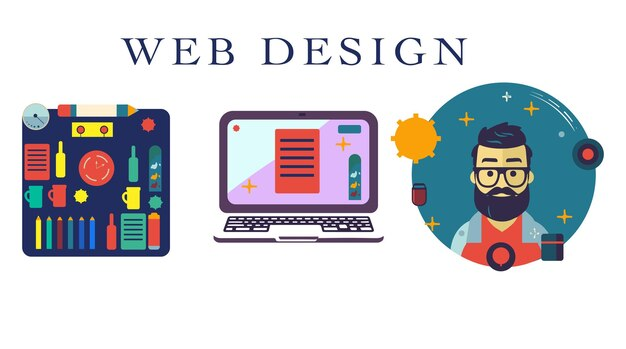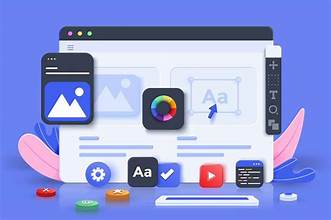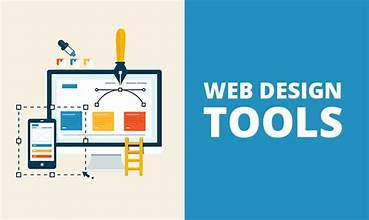Discover how Web Design for Business Growth and ROI transforms online performance in 2025. Learn key principles, tools, and trends that turn websites into conversion-driven digital experiences.

Introduction – The Power of Web Design in 2025
In today’s competitive digital marketplace, Web Design for Business Growth and ROI is more than aesthetics — it’s a strategic driver of success. A well-designed website shapes how users perceive, interact with, and trust your brand.
Whether you’re running an eCommerce store, SaaS platform, or enterprise site, web design directly impacts user experience, conversions, and brand reputation. With over 1.5 billion websites online, your design must do more than stand out — it must perform.
Background – The Evolution of Web Design
From Static Pages to Intelligent Digital Experiences
The evolution of web design reflects the story of the internet itself:
-
1991–1995 (HTML Era): Simple text-based layouts, no CSS or images.
-
1996–2005 (Flash & CSS Era): Colors, interactivity, and design separation emerged.
-
2006–2014 (Responsive Design Era): Smartphones made mobile-first design essential.
-
2015–Present (UX/UI Era): Focus shifted to usability, speed, and accessibility.
Today, web design for business growth means blending design psychology, functionality, and performance to deliver seamless experiences across every device.
In today’s fast-paced digital ecosystem, Web Design is far more than just creating visually appealing websites — it’s about crafting seamless, user-centered experiences that influence how users perceive, interact with, and trust a brand. Whether it’s an eCommerce store, a corporate site, or a SaaS platform, web design defines the first impression and ultimately determines conversion rates, brand perception, and customer retention.
With over 1.5 billion websites on the internet, businesses compete fiercely for user attention. A well-structured, functional, and aesthetically appealing web design can make the difference between success and failure in the digital world. It’s no longer just about aesthetics — it’s about strategy, performance, accessibility, and ROI.
This article provides an in-depth exploration of Web Design, covering its history, fundamental principles, best practices, ROI implications, and future trends. It is crafted for business owners, marketing professionals, and aspiring web designers who aim to understand how web design influences digital success.
Background Information — The Evolution of Web Design

From Static Pages to Interactive Experiences
The journey of Web Design began in the early 1990s when the first HTML-based websites appeared. These early sites were purely informational, consisting of static text and simple hyperlinks. However, as internet technology advanced, design became central to user experience.
- 1991–1995 (HTML Era): Basic layouts with plain text. No CSS, images, or multimedia.
- 1996–2005 (Flash & CSS Era): Introduction of interactivity, colors, and layouts. CSS separated design from content.
- 2006–2014 (Responsive Design Era): Smartphones revolutionized web design — fluid grids and adaptive layouts became essential.
- 2015–Present (UX/UI Era): User Experience (UX) and User Interface (UI) design define success. Websites now focus on speed, accessibility, and engagement.
Why Web Design Matters in 2025
- First Impressions: 94% of first impressions relate to web design and visual appeal.
- SEO and Usability: Google ranks websites based on page speed, mobile optimization, and design clarity.
- Conversion Optimization: A well-structured design can increase conversions by up to 200%.
- Brand Credibility: Users are 75% more likely to trust a business with a professionally designed website.
In 2025 and beyond, web design is the foundation of digital credibility and competitive differentiation.
Main Concepts of Web Design
Understanding the Core Principles
Effective Web Design integrates multiple disciplines — visual design, UX, development, and psychology — to create functional and appealing digital spaces.
Core Elements of Web Design Include:
- Layout: Defines the structure and navigation flow.
- Typography: Ensures readability and brand consistency.
- Color Psychology: Influences user emotions and actions.
- Imagery and Graphics: Enhances brand storytelling.
- Responsiveness: Guarantees a seamless experience across devices.
- Interactivity: Encourages engagement through animations, buttons, and dynamic elements.
When these principles are applied cohesively, the result is a website that not only looks good but performs effectively — generating measurable business outcomes.
UX (User Experience) and UI (User Interface): The Backbone of Modern Web Design
While UX focuses on how users interact with a site, UI concerns the visual presentation and aesthetic appeal.
| Aspect | User Experience (UX) | User Interface (UI) |
| Focus | Functionality & usability | Visual appeal & design |
| Objective | Simplify navigation & improve satisfaction | Create visually engaging layouts |
| Example | Smooth checkout process | Attractive button colors & typography |
Together, UX and UI ensure that web design drives engagement, conversions, and long-term user loyalty.
Key Components and Tools of Web Design

In this section, we explore five essential tools and techniques used in professional web design — comparing their features, usability, and ROI.
H2-1: Adobe XD – Prototyping and Collaboration
Adobe XD remains one of the most powerful tools for UI/UX design and prototyping. It allows designers to create interactive mockups and share them easily with developers and clients.
Features:
- Real-time collaboration
- Interactive prototypes
- Integration with Photoshop and Illustrator
ROI Perspective:
Using Adobe XD reduces design-to-development time by up to 40%, accelerating project delivery and cutting costs associated with revisions.
Case Example:
A digital agency using Adobe XD for client projects reported a 30% increase in productivity due to improved workflow and collaboration.
H2-2: Figma – The Cloud-Based Design Revolution
Figma has transformed modern web design through real-time collaboration and cloud-based editing.
Features:
- Cloud storage for accessibility
- Multi-user editing and feedback
- Component libraries for brand consistency
ROI Perspective:
Figma’s centralized approach reduces licensing costs and minimizes dependency on heavy software installations, making it ideal for remote teams.
Example:
A SaaS startup shifted to Figma and achieved 20% faster design iterations, leading to quicker launches and higher client satisfaction.
H2-3: WordPress – The Backbone of Modern Websites
Powering over 43% of all websites globally, WordPress remains the most versatile CMS for small and medium businesses.
Features:
- Thousands of design themes and plugins
- SEO-friendly structure
- Open-source and cost-effective
ROI Perspective:
WordPress reduces upfront costs of web development by up to 60% while offering scalability for future growth.
Example:
A retail brand migrated from a custom-coded platform to WordPress, saving $15,000 annually in maintenance and achieving a 40% increase in web traffic.
H2-4: Webflow – Design Meets Development
Webflow bridges the gap between visual design and front-end coding. Designers can build responsive websites visually without extensive programming knowledge.
Features:
- Visual drag-and-drop interface
- Built-in hosting and CMS
- SEO optimization tools
ROI Perspective:
Webflow enables designers to launch client-ready websites faster, cutting project delivery times by 50%.
Example:
An agency delivering marketing sites through Webflow reduced development cycles from 8 weeks to 4 weeks, doubling project output.
H2-5: Canva – Simplifying Visual Design for Non-Developers
Canva is not a traditional web design tool, but it plays a crucial role in content design — banners, mockups, and graphics essential for websites.
Features:
- Ready-to-use templates
- Drag-and-drop design system
- Collaboration tools
ROI Perspective:
For small businesses and entrepreneurs, Canva reduces design costs by allowing in-house content creation without hiring full-time designers.
Example:
A startup used Canva for its website graphics and saved $5,000 per year on design expenses, maintaining brand quality.
ROI, Strategy, and Real-World Impact of Web Design
ROI (Return on Investment) of Web Design
The success of a website can be measured through various performance indicators:
| Metric | Description | ROI Impact |
| Bounce Rate | Measures how long visitors stay | Lower bounce rate = higher engagement |
| Conversion Rate | Percentage of visitors who take action | Strong design boosts conversions |
| Page Speed | Loading time affects SEO and UX | Faster pages improve retention |
| Accessibility | Inclusive design broadens reach | Improves brand reputation and compliance |
ROI Insight:
Investing in Web Design yields an average return of 200–300%, as improved usability, faster load times, and brand consistency directly impact sales and customer trust.
Case Study: The Power of Redesign
A healthcare platform redesigned its outdated website with a responsive and user-centered layout. Results within 6 months:
- 50% increase in organic traffic
- 35% boost in appointment bookings
- 60% higher mobile engagement
This demonstrates that strategic web design directly influences business performance and revenue generation.
The Business Perspective
For business owners, web design is not a one-time investment — it’s a strategic asset that delivers long-term results through:
- Improved brand trust and visibility
- Better conversion funnels
- Enhanced customer experience
- Stronger SEO performance
Future Trends and Innovations in Web Design
- AI-Driven Personalization: Websites will adapt dynamically based on user behavior and preferences.
- Voice User Interface (VUI): Integration of voice search and commands in design.
- Minimalist and Clean Layouts: Focus on usability and load efficiency.
- Dark Mode and Accessibility Design: Aesthetic and user comfort combined.
- Augmented Reality (AR): Interactive experiences, especially in eCommerce and real estate sectors.
Web design will continue to evolve as a fusion of creativity, technology, and data-driven insights — emphasizing user-centricity as the foundation for digital success.
Conclusion: The Art and Science of Web Design
Web Design is both an art and a science — blending aesthetics with analytics, creativity with technology, and vision with measurable business goals. A well-designed website doesn’t just look beautiful; it works efficiently, converts effectively, and builds lasting customer relationships.
From tools like Adobe XD and Webflow to UX-driven strategies, web design defines how a brand interacts with its audience in the digital era. Businesses that invest strategically in Web Design reap measurable benefits — from higher ROI to stronger brand loyalty.
Call to Action: Transform Your Online Presence with Professional Web Design
Your website is your digital storefront — make it count. Whether you’re a startup building credibility or an enterprise enhancing user experience, professional Web Design can transform your business outcomes.
.


